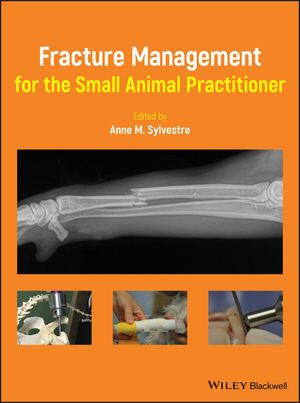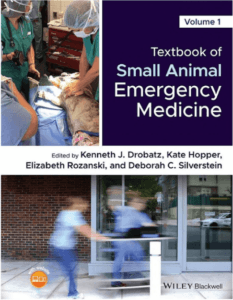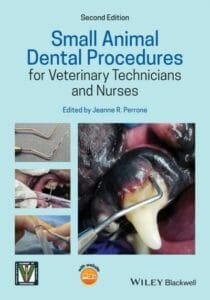Fracture Management for the Small Animal Practitioner

By Anne M. Sylvestre
Fracture Management for the Small Animal Practitioner PDF offers practical strategies and helpful approaches for managing fractures in dogs and cats.
• Contains all the information needed to successfully manage the most common fractures in dogs and cats
• Emphasizes clinically oriented tips for treating fractures from experienced surgeons
• Offers an abundance of color photographs to illustrate the techniques
List of Contributors xv
Preface xvii
Section 1 General Information 1
1 Fracture Identification 3
Anne M. Sylvestre
1.1 Number of Fragments 3
1.2 Fracture Configuration 3
1.3 Location on the Bone 7
1.4 Salter– Harris Fractures 7
2 Open Fractures 9
Anne M. Sylvestre
2.1 First Degree 9
2.2 Second Degree 9
2.3 Third Degree 9
Reference 10
3 Patient Management 11
Anne M. Sylvestre
3.1 The Patient 11
3.1.1 Upon Admission 11
3.1.2 Immediate Postoperative Care 11
3.1.3 Upon Discharge From Hospital 11
3.1.4 Outside and Walks 12
3.1.5 Follow‐up Radiographs and Healing Times 13
3.1.6 Implant Removal 13
3.2 The Owner 14
3.2.1 Slippery Floors 14
3.2.2 Stairs 15
3.2.3 No Jumping 15
3.2.4 Common Stressors 15
3.2.5 Crates 15
3.2.6 Icing 15
3.2.7 Gentle Passive Range of Motion (PROM) 16
3.2.8 Urination and Bowel Movements 16
3.2.9 Food and Water 16
3.2.10 Cats 17
3.3 Managing Osteoarthritis (OA) 17
References 17
4 Bandages and Splints 19
Jennifer White and Anne M. Sylvestre
4.1 The Bandage 19
4.1.1 Layers of a Bandage 19
4.1.2 Creating the Bandage 19
4.2 Forelimb 27
4.2.1 Velpeau Sling 27
4.2.2 Spica Bandage 30
4.2.3 Antebrachial Bandages 31
4.2.4 Bandages for a Manus 37
4.2.5 Carpal Flexion Sling 37
4.3 Hind Limb 39
4.3.1 Ehmer Sling 39
4.3.2 Robert Jones Bandage 39
4.3.3 Crural and Tarsal Bandages 39
4.3.4 Bandages for a Pes 47
4.3.5 Robinson and 90‐90 Slings 47
4.4 Bandage Care 47
4.4.1 Home Care Instructions 47
4.4.2 Bandage Changes 50
4.4.3 Bandage/Splint Complications 50
Reference 60
Section 2 The Forequarter 61
5 Mandible and Maxilla 63
Teresa Jacobson
5.1 Mandibular Fractures 63
5.1.1 Mandibular Symphyseal Separation 63
5.1.2 Rostral Mandibular Fractures 63
5.1.3 Fracture at the Level of the Mandibular First Molar 64
5.1.4 Temporomandibular Luxation 65
5.1.5 Other Mandibular Fractures 68
5.2 Maxillary Fractures 68
5.2.1 Fracture and/or Avulsion of the Incisive Bone 68
5.2.2 Fractures of the Maxillary Bone 68
5.3 Managing Expectations 68
5.4 Alternatives When the Treatment of Choice is Not an Option 68
5.5 Potential Complications of Maxillofacial Fracture Repair 69
References 74
6 Scapula 75
Anne M. Sylvestre
6.1 Fractures 75
6.1.1 Fractures Through the Body and Spine of the Scapula 75
6.1.2 Acromion Fractures 76
6.1.3 Fractures of the Neck of the Scapula 76
6.2 Managing Expectations with Recommended Treatments 78
6.3 Alternatives When Treatment of Choice is Not an Option 78
References 79
7 Shoulder Joint 81
Anne M. Sylvestre
7.1 Fractures and Luxations 82
7.1.1 Avulsion of the Supraglenoid Tuberosity 82
7.1.2 T or Y Fractures of the Scapular Neck and Glenoid Rim 82
7.1.3 Other Fractures Involving the Shoulder Joint 82
7.1.4 Medial Luxations 82
7.1.5 Lateral Luxations 84
7.2 Managing Expectations with Recommended Treatments 84
7.3 Alternatives When Treatment of Choice is Not an Option 86
7.3.1 Fractures 86
7.3.2 Luxations 86
References 86
8 Humerus 87
Catherine Popovitch, Thomas W.G. Gibson, and Anne M. Sylvestre
8.1 Fractures 88
8.1.1 Physeal Fractures of the Proximal Humerus 88
8.1.2 Two‐Piece Humeral Shaft Fractures 88
8.1.3 Multifragmented Humeral Shaft and/or Supracondylar Fractures 89
8.2 Managing Expectations with Recommended Treatments 90
8.3 Alternatives When Treatment of Choice is Not an Option 90
References 91
9 Elbow Joint 93
Anne M. Sylvestre
9.1 Fractures and Luxations 94
9.1.1 Condylar Fractures 94
9.1.2 Bicondylar Fractures 94
9.1.3 Acute Luxations 94
9.1.4 Chronic Luxations 99
9.1.5 Proximal Ulnar Fractures 100
9.1.6 Monteggia Fractures 100
9.2 Managing Expectations with Recommended Treatments 101
9.3 Alternatives When Treatment of Choice is Not an Option 101
9.3.1 For Patients with a Fracture 101
9.3.2 For Patients with a Luxation 102
References 102
10 Radius and Ulna 105
Catherine Popovitch, Thomas W.G. Gibson, and Anne M. Sylvestre
10.1 Fractures 106
10.1.1 Fractures of the Proximal Ulna 106
10.1.2 Fractures of the Proximal Radius 106
10.1.3 Fractures of the Radius in Toy Breed Dogs 106
10.1.4 Fractures of the Radius and Ulna in Non‐Toy Breed Dogs and Cats 107
10.1.5 Isolated Fractures of the Shaft of the Ulna 112
10.1.6 Physeal Fractures of the Distal Radius 112
10.2 Managing Expectations with Recommended Treatments 114
10.3 Alternatives When Treatment of Choice is Not an Option 114
References 117
11 Carpal Joint 119
Anne M. Sylvestre
11.1 Fractures and Ligamentous Injuries 120
11.1.1 Fractures of the Styloid Process of the Radius or Distal Ulna 120
11.1.2 Fractures of the Radial Carpal Bone 120
11.1.3 Fractures of the Accessory Carpal Bone 122
11.1.4 Fractures of the Ulnar Carpal Bone 123
11.1.5 Collateral Ligament Injuries 123
11.1.6 Shearing Injuries 124
11.1.7 Hyperextension Injuries 125
11.1.8 Luxation of the Antebrachiaocarpal Joint 125
11.1.9 Luxation of the Accessory Carpal Bone 125
11.1.10 Luxation of the Radiocarpal Bone 126
11.2 Managing Expectations with Recommended Treatments 127
11.3 Alternatives When Treatment of Choice is Not an Option 127
11.3.1 For Patients with a Fracture 127
11.3.2 For Patients with Ligamentous Injuries 128
11.4 About Pancarpal Arthrodesis 128
11.5 About Partial Carpal Arthrodesis 128
References 129
Section 3 The Hindquarter 131
12 Pelvis 133
Anne M. Sylvestre
12.1 Co‐morbidities 134
12.2 Fractures 134
12.2.1 SI Luxations/Fractures 134
12.2.2 Fractures of the Ilial Shaft or Wing 134
12.2.3 Acetabular Fractures 137
12.2.4 Ischial Fractures 137
12.2.5 Fractures of the Pelvic Floor 137
12.2.6 Summary of Indications for Surgical Repair of Pelvic Fractures 138
12.3 Managing Expectations with Recommended Treatments 139
12.4 Alternatives When Treatment of Choice is Not an Option 139
References 140
13 Coxofemoral Joint 141
Thomas W.G. Gibson and Anne M. Sylvestre
13.1 Fractures and Luxations 141
13.1.1 Acetabular Fractures 141
13.1.2 Hip Luxations 142
13.1.3 Alternative Treatment of Choice: Open Reduction 146
13.1.4 Capital Physeal Fractures of the Proximal Femur 148
13.1.5 Fractures of the Femoral Neck 149
13.2 Managing Expectations with Recommended Treatments 150
13.3 Alternatives When Treatment of Choice is Not an Option 150
13.3.1 Acetabular Fractures 150
13.3.2 Luxations 150
13.3.3 Femoral Head and Neck Fractures 151
13.4 About the FHO 151
References 152
14 Femur 153
Thomas W.G. Gibson and Anne M. Sylvestre
14.1 Fractures 154
14.1.1 Avulsion Fractures of the Greater Trochanter 154
14.1.2 Fractures of the Femoral Shaft 154
14.1.3 Physeal Fractures of the Distal Femur 157
14.2 Managing Expectations with Recommended Treatments 159
14.3 Alternatives When Treatment of Choice is Not an Option 159
References 161
15 Stifle Joint 163
Anne M. Sylvestre
15.1 Fractures and Luxations 164
15.1.1 Articular Distal Femoral Fractures 164
15.1.2 Patellar Fractures 164
15.1.3 Traumatic Patellar Luxations 166
15.1.4 Collateral Ligament Damage 166
15.1.5 Luxation of the Stifle Joint 166
15.1.6 Articular Proximal Tibial Fractures 169
15.2 Managing Expectations with Recommended Treatments 170
15.3 Alternatives Treatment When Surgery is Not an Option 170
References 170
16 Tibia and Fibula 171
Thomas W.G. Gibson and Anne M. Sylvestre
16.1 Fractures 172
16.1.1 Tibial Tuberosity Avulsion Fractures 172
16.1.2 Tibial Plateau Physeal Fractures 172
16.1.3 Proximal Tibial Shaft Fractures 173
16.1.4 Fractures of the Mid‐ and Mid‐to‐Distal Portions of the Tibial Shaft 173
16.1.5 Fractures of the Distal Tibial Shaft 177
16.1.6 Physeal Fractures of the Distal Tibia/Fibula 177
16.1.7 Fractures of the Fibular Shaft Alone 177
16.2 Managing Expectations with Recommended Treatments 178
16.3 Alternatives When Treatment of Choice is Not an Option 178
References 181
17 Tarsal Joint 183
Anne M. Sylvestre
17.1 Fractures and Ligamentous Injuries 184
17.1.1 Articular Distal Tibial Fractures 184
17.1.2 Fractures of the Medial Malleolus or the Lateral Malleolus 184
17.1.3 Medial or Lateral Collateral Ligament Injuries 186
17.1.4 Luxations of the Tarsocrural Joint 186
17.1.5 Shearing Injuries 186
17.1.6 Fractures of the Calcaneus 188
17.1.7 Fractures/Luxations of the Talus 192
17.1.8 Fractures/Luxations of the Central Tarsal Bone 193
17.1.9 Fractures of the Numbered Tarsal Bones 193
17.1.10 Luxation of the Intertarsal and/or Tarsometatarsal Joints 194
17.2 Managing Expectations with Recommended Treatments 194
17.3 Alternatives When Treatment of Choice is Not an Option 195
17.4 About Pantarsal Arthrodesis 195
17.5 About Partial Tarsal Arthrodesis 195
References 197
18 Paw (Manus and Pes) 199
Anne M. Sylvestre
18.1 Fractures and Luxations 199
18.1.1 MC/MT Fractures 199
18.1.2 Phalangeal Fractures 202
18.1.3 Luxations of the Inter‐Phalangeal or MC/MT‐Phalangeal Joints 203
18.2 Managing Expectation with Recommended Treatments 204
18.3 Alternatives When Treatment of Choice is Not an Option 204
References 204
Section 4 Fracture Repair Techniques 205
19 Essential Information on Fracture Repair 207
Anne M. Sylvestre
19.1 Forces Applied to a Bone 208
19.2 Techniques for Reducing a Fracture 208
19.2.1 Distraction 209
19.2.2 Lever 209
19.2.3 Toggle 209
19.2.4 Oblique Fractures 210
19.2.5 Using the Plate 211
19.3 Instrumentation 211
19.3.1 Drills 211
19.3.2 Fracture Repair General Instruments 213
References 214
20 Pins and Wires 215
Catherine Popovitch
20.1 Case Selection 215
20.2 Instrumentation 215
20.3 Fundamentals of Application 215
20.3.1 Cerclage Wires 215
20.3.2 Pins 216
20.4 Pinning Techniques for Various Long Bones 218
20.4.1 Humerus 218
20.4.2 Radius 218
20.4.3 Femur 218
20.4.4 Tibia 220
References 221
21 Plating 223
Anne M. Sylvestre
21.1 Case Selection 223
21.2 Instrumentation 223
21.2.1 Bone Screws 223
21.2.2 Bone Plates 224
21.2.3 Plating‐specific Instruments 225
21.3 Fundamentals of Application 226
21.3.1 Selecting a Plate 226
21.3.2 At Surgery 227
21.3.3 Pin–Plate Combination 228
21.3.4 Stack Plating 230
21.4 Postoperative Care 230
21.5 Plating Techniques for Various Long Bones 230
21.5.1 Humerus 230
21.5.2 Radius 230
21.5.3 Femur 230
21.5.4 Tibia 232
References 233
22 External Fixators 235
Kathryn Wander
22.1 Case Selection 235
22.2 Basic Rules of External Fixation 235
22.2.1 Pins 235
22.2.2 Connecting Bars 236
22.2.3 Clamps 236
22.3 Fundamentals of Application 237
22.4 Fixators: Biomechanics/Constructs 237
22.4.1 Acrylic Splints/Constructs 238
22.4.2 Circular External Fixators 239
22.5 Postoperative Care 239
22.6 Complications 241
22.7 Preferred Technique for Various Long Bones 242
22.7.1 Tibial Fractures 242
22.7.2 Humeral Fractures 242
22.7.3 Femoral Fractures 242
22.7.4 Radial Fractures 242
References 243
23 Repair of Physeal Fractures 245
Thomas W.G. Gibson
23.1 Physeal Fractures 245
23.1.1 Crossed Pin Technique 246
23.2 Avulsion Type Physeal Fractures 247
23.2.1 Tension Band Wiring Technique 247
23.3 Repair Techniques for Various Physeal Fractures 247
23.3.1 Proximal Humerus 247
23.3.2 Proximal Ulna 247
23.3.3 Proximal Radius 247
23.3.4 Distal Radius 247
23.3.5 Greater Trochanter 248
23.3.6 Distal Femur 248
23.3.7 Tibial Tuberosity 248
23.3.8 Proximal Tibial Physis 248
23.3.9 Distal Tibial Physis 248
References 248
24 Fractures of the Jaw 251
Teresa Jacobson
24.1 Anatomical Considerations 251
24.2 Jaw Fracture Management 251
24.2.1 The Principles of Jaw Fracture Management 252
24.2.2 Intubation Considerations for the Fracture Repair 253
24.2.3 Feeding Plan Post Jaw Fracture Repair 253
24.3 Pain Management 254
24.4 Maxillofacial Fracture Repair 255
24.5 Methods of Maxillofacial Fracture Stabilization 257
24.5.1 Tape or Nylon Muzzles 257
24.5.2 Osseous Wiring Techniques for Maxillofacial Fracture Repair 257
24.5.3 Intra‐Dental Wiring Techniques with Acrylic Reinforcement 260
24.5.4 Bonding the Maxillary to the Mandibular Canines 265
24.6 Bone Grafts 266
24.7 Teeth in the Fracture Line 266
24.8 Antibiotic Therapy in Maxillofacial Fracture Repair 267
24.9 Irrigation of the Appliance 267
24.10 Recheck Examinations 267
References 267
25 Approaches to the Long Bones 269
Anne M. Sylvestre
25.1 Approach to the Diaphysis of the Humerus 269
25.1.1 Patient Position 269
25.1.2 The Surgical Approach 269
25.2 Approach to the Diaphysis of the Radius 271
25.2.1 Patient Position 271
25.2.2 Surgical Approach 271
25.3 Approach to the Femoral Diaphysis 271
25.3.1 Patient Position 271
25.3.2 The Surgical Approach 272
25.4 Approach to the Tibial Diaphysis 272
25.4.1 Patient Position 272
25.4.2 The Surgical Approach 272
Reference 274
26 Implants 275
Harold Wotton
26.1 Maneuvering Orthopedic Implants 275
26.2 Quality Implants: Essential Information on Quality Implants 276
26.3 Titanium vs Stainless Steel 276
Index 279
You May Also Like:













![Ettinger’s Textbook of Veterinary Internal Medicine 9th Edition [PDF+Videos] Ettinger’s Textbook of Veterinary Internal Medicine 9th Edition [True PDF+Videos]](https://www.vet-ebooks.com/wp-content/uploads/2024/10/ettingers-textbook-of-veterinary-internal-medicine-9th-edition-100x70.jpg)

![Textbook of Veterinary Diagnostic Radiology 8th Edition [PDF+Videos+Quizzes] Thrall’s Textbook of Veterinary Diagnostic Radiology, 8th edition PDF](https://www.vet-ebooks.com/wp-content/uploads/2019/09/textbook-of-veterinary-diagnostic-radiology-8th-edition-100x70.jpg)






